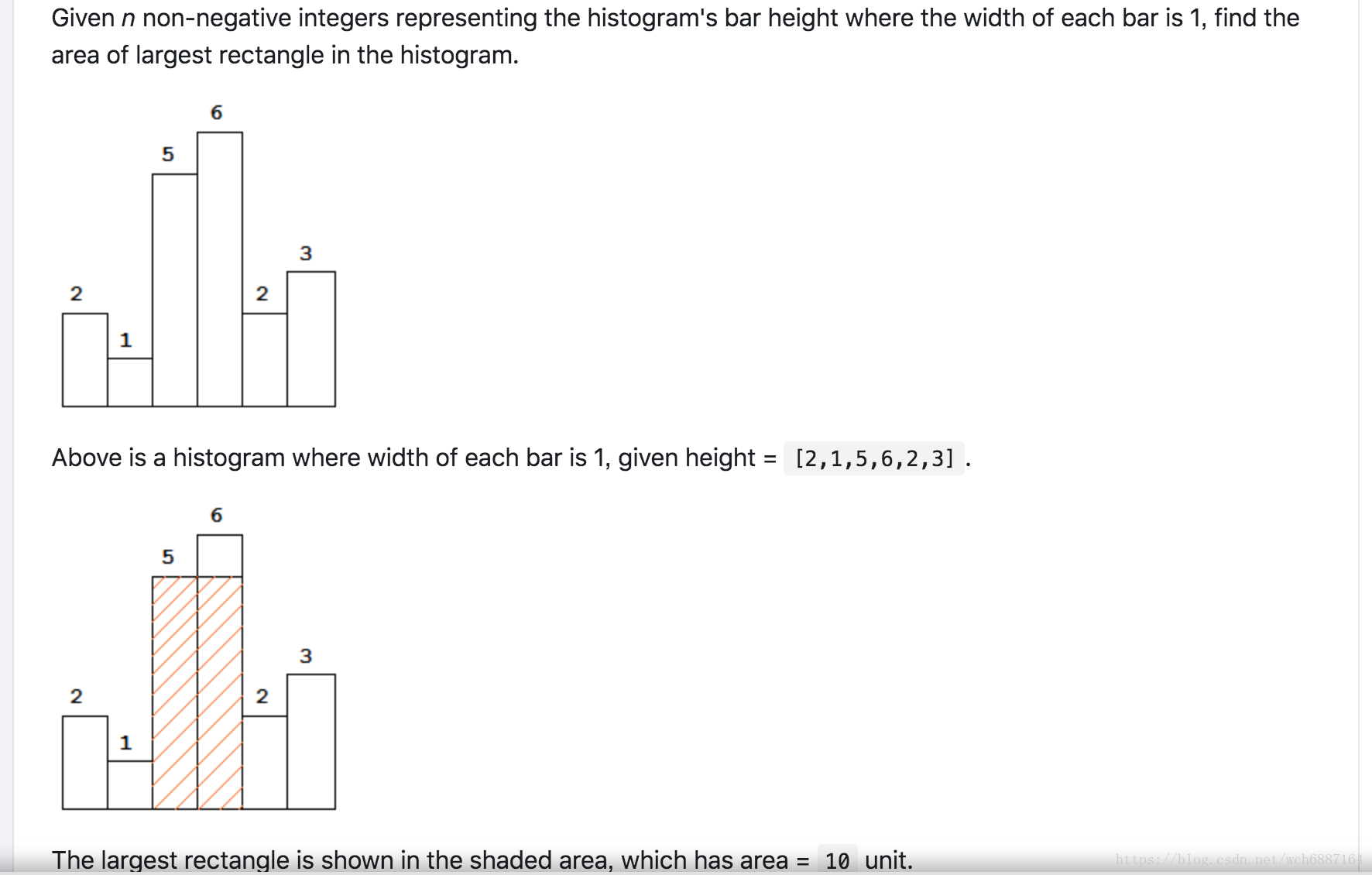一、栈
问题:largest-rectangle-in-histogram
描述:

思路:构造一个递增栈,一旦push入栈的元素比栈顶元素小的时候,就计算包括栈顶元素的面积最大值。
public class Solution {
/**
* @param height: A list of integer
* @return: The area of largest rectangle in the histogram
*/
public int largestRectangleArea(int[] height) {
// write your code here
if(height==null||height.length==0)
return 0;
Stack<Integer> stack =new Stack<>();
int max = 0;
for(int i=0;i<=height.length;i++){
int tem =(i==height.length)?-1:height[i];
while(!stack.isEmpty()&&height[stack.peek()]>tem){
int h = height[stack.pop()];
int w = stack.isEmpty()?i:i-stack.peek()-1;
max = Math.max(max,h*w);
}
stack.push(i);
}
return max;
}
}二、哈希表

LRU缓存策略(Least recently used,最近最少使用)
思路:把双向链表和HashMap结合起来

public class LRUCache {
/*
* @param capacity: An integer
*/
public class Node{
Node pre ;
Node next ;
public int val;
public int key;
public Node(int key,int val){
this.val = val;
this.key = key;
pre = null;
next = null;
}
}
private int capacity;
private Node head;
private Node tail;
private Map<Integer,Node> map;
public LRUCache(int capacity) {
// do intialization if necessary
this.capacity = capacity;
head = new Node(-1,-1);
tail = new Node(-1,-1);
map = new HashMap<Integer,Node>();
head.next = tail;
tail.pre = head;
}
/*
* @param key: An integer
* @return: An integer
*/
public int get(int key) {
// write your code here
if(!map.containsKey(key))
return -1;
Node node = map.get(key);
node.pre.next = node.next;
node.next.pre = node.pre;
move2Tail(node);
// System.out.println("key="+key+",value="+node.val);
return node.val;
}
public void move2Tail(Node node){
node.pre = tail.pre;
tail.pre.next = node;
node.next = tail;
tail.pre = node;
}
/*
* @param key: An integer
* @param value: An integer
* @return: nothing
*/
public void set(int key, int value) {
// write your code here
if(map.containsKey(key)){
Node temp = map.get(key);
temp.pre.next = temp.next;
temp.next.pre = temp.pre;
move2Tail(temp);
temp.val = value;
return;
}
if(map.size()==capacity){
map.remove(head.next.key);
head.next.next.pre = head;
head.next = head.next.next;
}
Node cur = new Node(key,value);
map.put(key,cur);
// System.out.println("SET key="+key+",value="+cur.val);
move2Tail(cur);
}
}
三、heap

Add 插入的时候,将需要插入的元素放在最下面一层最左边的空位。在跟父节点比较,如果比父节点小则一直交换。
Remove的时候,把最后一排最右边的点于根节点交换,并且把那个位置的数删除,然后不断与其小一点的子节点交换,不断重复。
PriorityQueue
题目:丑数

思路:通过PriorityQueue和HashMap实现
public class Solution {
/**
* @param n: An integer
* @return: the nth prime number as description.
*/
public int nthUglyNumber(int n) {
// write your code here
if(n==1)
return 1;
PriorityQueue<Integer> que = new PriorityQueue<>();
Map<Integer,Integer> map = new HashMap<>();
Integer[] uglys = new Integer[3];
uglys[0] = Integer.valueOf(2);
uglys[1] = Integer.valueOf(3);
uglys[2] = Integer.valueOf(5);
for(int i=0;i<3;i++){
que.add(uglys[i]);
map.put(uglys[i],1);
}
Integer tem = Integer.valueOf(0);
for(int i=1;i<n;i++){
tem = que.poll();
for(int j=0;j<3;j++){
if(tem*uglys[j]<Integer.MAX_VALUE&&!map.containsKey(tem*uglys[j])){
que.add(tem*uglys[j]);
map.put(tem*uglys[j],1);
}
}
}
return tem;
}
}题目二、前K大的数2
public class Solution {
/*
* @param k: An integer
*/
private PriorityQueue<Integer> que;
private int k;
public Solution(int k) {
// do intialization if necessary
this.k = k;
que = new PriorityQueue<>(k,new Comparator<Integer>(){
public int compare(Integer a1,Integer a2){
return a1-a2;}
});
}
/*
* @param num: Number to be added
* @return: nothing
*/
public void add(int num) {
// write your code here
if(que.size()<k){
que.add(num);
}else{
if(num>que.peek()){
que.poll();
que.add(num);
}
}
}
/*
* @return: Top k element
*/
public List<Integer> topk() {
// write your code here
int size = que.size();
Integer[] arr = new Integer[size];
for(int i=size-1;i>=0;i--){
arr[i] = que.poll();
}
for(int i=0;i<size;i++){
que.add(arr[i]);
}
return Arrays.asList(arr);
}
}





















 4496
4496

 被折叠的 条评论
为什么被折叠?
被折叠的 条评论
为什么被折叠?








